
|

|
| The Royal Oak | Okehampton Street |
| The Kings | The library |
| Imperial China Restaurant & Bar | Railway buildings and Brunel's viaduct etc.. |
| The Longbrooke | St Thomas Shopping Centre and surrounds |
| The Showman | Parish Church and Firehouse |
| The Sawyers | Methodist Church and Health Centre |
| The First and Last | The Last Tram |
| The Cowick Barton Inn | Cowick Lane and Cowick Priory |
| The Seven Stars and Crawford Hotel | Alphington Road |
| Use the text links for more information! |
No sidebar menus?, Click Here and re-select |
|
When you arrive in St Thomas you realise that its flat, something
rare in residential Exeter. St. Thomas is built on the lowlands between
redhills and the river, on what was at one time an extensive flood plain.
Alluvial deposits sit beneath the streets rather than solid rock and it
is for this reason that with recent draughts, notably that of 1976 the
land has dried to such an extent that a fair amount of shrinkage has taken
place and a few of the Victorian homes have been affected by subsidence.
Royal Oak
Go down Okehampton Street and you'll find the Royal Oak, this is where you start your tour of St Thomas. Excellent choice of beers and nice decor and good food. What more could you want? During the floods of 1960 a full barrel of beer was washed down the Exe from this pub on 27th October. It was recovered by HMS Highburton on December 8th, seven miles east of Portland. The barrel was returned to the brewery who showed their appreciation by entertaining the crew. This beer barrel now rests in the public bar as a seat with a brass plate commemorating the incident. So why is the place called the Royal Oak? Not an Oak tree in sight! In the 17th century the river bank was lined with a row of enormous oak trees. |
|
Kings Halls
Just over the road towards Exe Bridges
the Christian Centre used to be the King's Halls. It became a cinema
and then a series of night clubs and rock venues. The Police (supporting Albertos
Y los trios Paranoias) and the Stranglers played here in the early eighties when
the place was known as Roots. The Jolt (supporting The Motors) also played here in
the early eighties. They were quite well named because their lead received an
electric shock from the mike and the show was postponed until the following night.
At other times between various mysterious unexplained fires, it has been known as
Zhivago's, The Riverside and The Power House. For a while after it closed as
a nightspot, it had a brief career as an indoor paint-ball centre.
Seven Stars
The Seven Stars used to stand close to this site, it later became Howards Commercial Hotel.
The pub name though has survived in Alphington Road opposite the entrance to Marsh Barton
Industrial Estate. The original pub was one of 16 Devon pubs displaying the emblem of St John
Nepomuk, martyred in the River Vltava by King Wencelas.
|
| West Of England Brewery
The directories suggest that a brewery at the end of Okehampton Street existed in 1878 (W), run by William & William
Mortimore (father and son) at 41 Okehampton Terrace and 15 Swan Yard. The Swan was an old inn that fronted onto Cowick
Street.
By 1923, Carr and Quick Ltd ran the brewery, named as the West of England Brewery at 8 Okehampton Street. The company
were mainly engaged in bottling and later had premises in Queen Street, so it is likely that brewing ceased when this
company took over the brewery.
|
| Demolition The development of the twin Exe Bridges and traffic scheme prompted the clearing of many of the buildings that stood at the end of Cowick Street and Alphington Street in 1960/61/62. An article in the Express & Echo at the time described this demolition as the biggest carried out since the blitz. The first bridge was opened in 1973. |
|
|
|
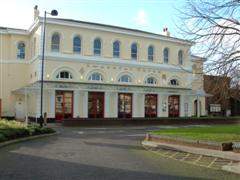 |
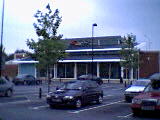
|
Retail Park
Sainsburys once occupied the site of the Riverside Retail Park and opened in March 1986, closing in November 1998.
A public library was built at around the same time (1985). The leisure centre was also built around this time as a
joint venture between the council and the developers (Rush and Tompkins), it was originally known as The Plaza.
The building was taken on by the city council after the developers went bankrupt. The building has
always had its problems, be it leaking pools or admission charges. It re-opened in late 2000 after a facelift and
re-design of the pool area, and is now known as the Riverside Leisure Centre. The site was once the home of Wadham Stringer
but earlier still between 1560 and 1624,it was the home of the Birdall Bell Foundry.
The Pizza restaurant was originally built without a kitchen and therefore opened a little later.
Imagine opening a pub without a bar. Priceless!
|
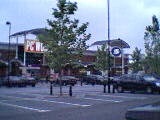
|
| On the coner of Haven Road is Ashmore Court, opened in 2003. Sixteen two bed appartments are located above retail units and cost 1.3 million pounds. The building is another example of how the City is trying to build affordable homes for local people. The brownfield site had stood derelict for years but was once the site of Pike's Garage. | 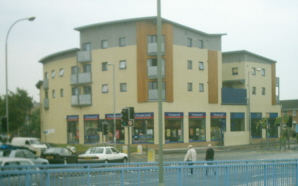
|
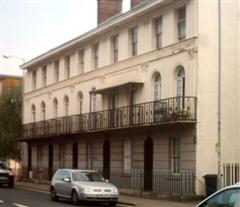 |
Further down Alphington Road are Hampden Place from the Regency period with the late Georgian brick built Sidney Villas next door. These are excellent examples of architecture and are well worth a look. | 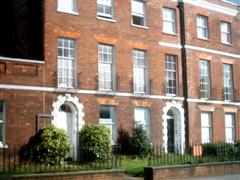 |
|
|
The year 1403 saw the first flooding of sufficient magnitude to
remove buildings. The Church of St. Thomas the Martyr was washed away followed
hours later by an earlier edition of Exe Bridge.
The torrent through some of these streets during the floods
of 1960 was enough to turn over cars, the water in some places was over
waist high. After this flooding, several flood prevention
schemes were put in place and these account for the geometry of the river through the
city today.
Gateway developed the shopping centre in 1972 at the corner of which stands The Longbrooke at around the same time the new bridges and flood preventions schemes were put in place. Picturesque shops and houses were demolished to make way for the shopping centre including two Elizabethan Inns with courtyards, the Turks Head and Moreton Inn. The Swan Inn used to stand over the road and the Railway Inn where the Nat West reside. |
| Debt
On the Cowick Street side of Cowick Street Motors is an arch, the
Gateway of Sherriff's Ward. The Sheriff's ward or The Devon County Prison for Debtors
was built in 1818, only the entrance now remains. The year 1853 saw the
debtors
moved to the County Gaol and the building became a storehouse for the
Devon Militia, hence the name, Valiant Soldier a former name for The Longbrooke.
The storehouse was demolished in the 1970's, but by then the building was a tennement block.
In 1892, the Militia had left the site and the building was turned into artisans dwellings.
1909 saw all but a wing of the former prison demolished to make way for the Wesleyan Church.
The remainder was converted into the tennements mentioned above.
In 1939, Wippels took over a factory at the northern end of the old prison yard where an
original and older prison will have stood, John Holts
currently use the Wesleyan Church to sell carpets and furniture. The pop ups give more detail.
|
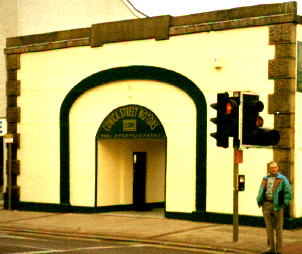 |